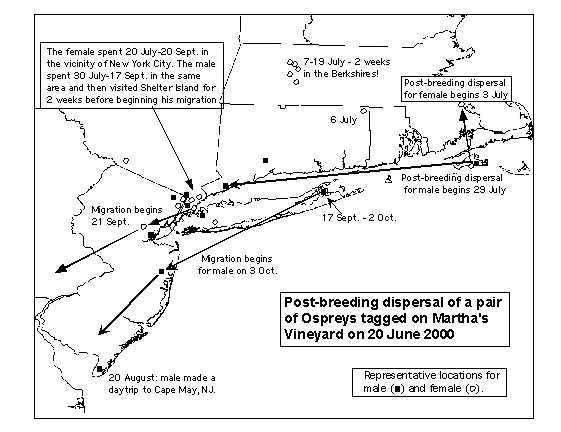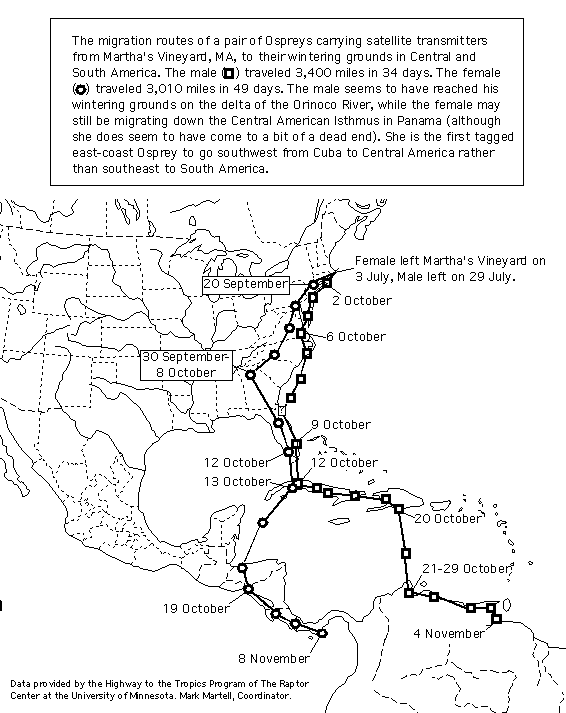Project Osprey
Watch
Citizen Scientists Tracking the
Vineyard Ospreys
Number 3 November 2000
![]()
Contents (click to jump to):
Satellite Tracking Program Begins
The 2000 Season Summary
Easy Pickin's
1999 Data Reviewed
Post-breeding Dispersal
Map
Follow the Migration
Map
Funding Solicited
Web Links
![]()
Itís November and we DO know where our Ospreys are!
At least two of them, anyway. Thanks to a most generous donation, this spring we put satellite transmitters on a pair of Vineyard Ospreys and have been following their peregrinations (!) on a daily basis since the 20th of June.
We are collaborating with the "Highway to the Tropics" program of the Raptor Center at the Univ. of Minnesota. Mark Martell, the project's coordinator, has put transmitters on 110 Ospreys over the past several years in an ongoing effort to learn about their migration. Ours are the first birds tagged in Massachusetts.
Before satellite telemetry, our knowledge of Osprey migration was limited to the recovery of banded birds, which are almost always dead when recovered. So all we could tell was where a bird had been banded and where it was when it died. Now we are learning what Ospreys do on their travels to and from the wintering grounds. Will they take the same routes each year to the same wintering grounds? Are there bottlenecks through which much of the population migrates and where they might be vulnerable?
Another important benefit of the program is environmental education. School groups can pick an Osprey banded locally and follow via the Internet "their" bird's migration. In the process, they learn about raptors, migration, conservation, as well as geography, social studies, and math. Next year we hope to tag several birds on the Island (especially the Felix Neck birds) and get Vineyard classes involved. Fund raising is ongoing and off to a good start.
![]()
This season, the Vineyard Ospreys had their best year since Project Osprey Watch got underway in 1998. It may have been the best year since for Osprey reproduction on Martha's Vineyard since 1992.
With data still pending from only 3 nests (we're getting better) here are the totals: (we won't demand a recount!)
| Breeding pairs | 62 |
| Housekeepers | 5 |
| Successful nests | 54 |
| Failures | 8 |
| No data | 4 |
| Young fledged | 96 |
The 96 young fledged is a conservative estimate (some nests were checked after the young had already been on the wing and some could have missed). This translates to just over 1.5 fledged per active nest, up significantly from last year's 1.19. Nine nests fledged three young and the pair at Wasque succeeded in raising four!
Click to see the full data set for all nests in 2000.
![]()
Edgartown Great Pond wasn't opened to the ocean until quite late in the summer, to the delight of the Ospreys in that corner of the Island. Huge schools of herring--one of the Ospreys' favorite food items, were stuck in the pond and bunched up along the south end of the pond, driven by their instincts to get back out to sea. Thousands of herring in shallow water provided an all-you-can-eat smorgasbord for the local Ospreys. Reliable sources report Ospreys routinely catching two herring in a single dive, with one overachiever getting out of the water with three herring in its talons before dropping one of the three!
![]()
When the data from the last few nests came in for 1999, the Vineyard birds had had another successful breeding season:
| Breeding pairs | 63 |
| Housekeepers | 6 |
| Successful nests | 40 |
| Failures | 12 |
| No data | 11 |
| Young fledged | 84 |
The number of nests started was down 3 from 1998, housekeeping pairs up by 2, nest failures down from 18 to 12, and the average number of young fledged per active nest up slightly from 1.15 to 1.19. The only unfortunate trend in the numbers was the increase in nests for which we had no data (this year we did much better).
Click here to see the revised 1999 data for all nests.
![]()
About two weeks after Rob and Mark outfitted the Ospreys with their transmitters, the parents lost the single young that had been in the nest. We don't know what happened to the nestling. We do know, thanks to the transmitter on her back, that the female left the Island almost immediately and spent a few days around Plymouth, MA, before heading east and north to the Berkshires (to our utter amazement), where she spent a couple of weeks before moving south to the NYC area.
The male stayed around the nest until the end of July, when he too abandoned the Island in favor of the NYC environs, taking the more conventional, straight-line approach.
So are these birds migrating? Technically, no. "Migration" is the directed movement between (usually) a breeding area and a wintering one. Once our birds lost their young, their instinctive connection to the breeding territory was severed, but the natural stimulation for migration (shortening day length) had not yet triggered that behavior, so they were free to wander about in search of an ample supply of fish.
We might speculate that the female, leaving as early as she did, didn't even feel a hint of the migratory instincts that would eventually guide her to Central, and probably, South America. This would explain her northward movement after leaving the Vineyard. The male, in contrast, left the Island a little later in the season and moved on what we imagine to be the typical migratory route for our Island birds.
Once the two birds settled into the NYC area, we were able to follow their
wanderings as they killed time (and fish) before beginning their true southbound
migration in September and October. Both birds moved around quite a bit and
often returned to several favorite locations.
Map of post-breeding dispersal (not yet migrating!)

Both spent almost two weeks at one spot (her's was Pelham Bay, his was Shelter Island) before moving south. Perhaps they need to find really good fishing to build up the energy reserves they'll need for their 3,000+ mile trip to the tropics.
To follow the birds' movements (including their return next spring) go to http://www.birdsofprey.org/migration.htm and follow the links to the Vineyard birds.
![]()
The Excellent Adventures of "HW" and "HX"
Our two birds, known by the letter codes on their leg bands, began their true migration in late September and early October.
HW, the female, left Pelham Bay Park, where she had been parked for a couple of weeks, on September 21st. She took a southwesterly route, foreshadowing much of her migration, and avoided the issue of crossing either Delaware or Chesapeake Bay by taking the inland route. She stopped at the Susquehanna River for a few days before again pushing off, passing into Virginia just south of Washington, DC. In a remarkable coincidence, she spent an afternoon at the large lake just north of Charlotte, NC, perhaps seeking revenge on the so-and-so who attached the transmitter to her back!
She then found Lake Lanier in Georgia, where she spent a week or so before finally correcting her route (she was heading for New Orleans) and moving south to Florida. From there she did what all south-bound, east-coast Ospreys do--the short hop to Cuba.
After arriving in Cuba, she once again surprised us by going southwest across the Caribbean Sea to Honduras! Every other Osprey that has been satellite tagged has gone southeast along Cuba, with almost all then hopping over to Haiti and from there crossing 4-500 miles of open water and arriving in Venezuela or Colombia.
Once in Central America, she continued west and with several short stopovers made her way to the Panamanian border, perhaps en route to South America. It's quite likely that she got her feathers wet in the Pacific Ocean--a very rare event for an east-coast Osprey! She then moved along the Central American isthmus and was last heard from well into Panama on the Azuero Peninsula.
Meanwhile, the male hung around Shelter Island on the eastern tip of Long Island and gave the female an 11-day headstart before starting his migration on the 2nd of October. Once on the move, he took the inside track, moving down the coast, crossing the Delaware Bay near Cape May, NJ. After a bit of an inland swing, he was back on the coast near Topsail Beach, just north of Wilmington, NC. From there, he moved down the coast to Bald Head Island and then headed out over open water for a long haul to Florida. Wasting no time, he moved down the east coast of Florida, made the jump over to Cuba, and then followed the well-worn Osprey trail southeast along the island before puddle-jumping to Haiti. From there he moved south across the Caribbean to Venezuela. After a week's rest near Maracaibo, he moved east through northern Venezuela, making a bee line for the delta of the Orinoco River. He covered 780 miles in six daysó130 miles a dayóand appears to have settled in to the vast network of canals and islands that must be an Osprey paradise.
During his trip from Shelter Island to the Orinoco he flew about 3,400 miles in 34 days, for an average of 100 miles per day of migration. However, he did sit and rest a bit at least twice, so his average distance covered on "moving days" was more the 100 miles.

![]()
Top - Home - Habitat Fragmentation - Neotropical Birds - Birds of Prey - Project Barn Owl - Graduate Students - Conservation Organizations - Publications - Ornithology - Osprey Watch - 98 Osprey Data - 99 Osprey Data